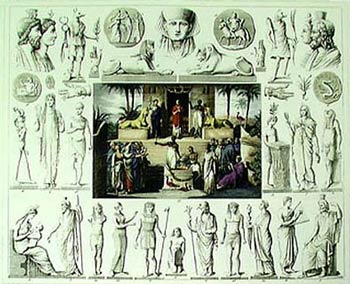
Pictures That Became Words
by Tony Leather
We are surrounded, on all sides, by the written word; letters, newspapers, flyers and even text messages on our mobiles. There is never any real thought about it in our minds, because our ability to make sense of the writing is taken for granted, yet it wasn’t so very long ago, in history, that the ability to read and write was very much a privilege of the few.
Less than 20% of the people of England could even sign their names, in Elizabethan times -- a period regarded as one of literature’s golden periods - yet before that, only the priestly castes, or the very powerful, received the necessary education in reading and writing. Even today, there are 900 million adults in the world who are illiterate.
It is believed that humans have had the power of speech for at least 50,000 years, yet writing is comparatively new, first appearing about 9,000 years ago -- though today’s reader might not class it as such. Clay tokens, bearing images of trade goods, began to be exchanged by traders in ancient Sumeria (now called Iraq ), and by 3,300 BC, this had developed into a kind of pictorial alphabet, named the Cuneiform.
Trade and religion were the founding causes of writing, and it’s known that the Cuneiform had over 2,000 symbols, developing into a ‘language’ which could portray complex subjects. The first ever written story -- The Epic of Gilgamesh -- was written in this script. Cuneiform was, like Chinese, a language of symbolic pictures, and ancient Egyptians were developing their own, known as "heiroglyphs," at around the same time.
This script was much simpler, originally having only 24 symbols, and was named ‘sacred engraved writing’ by the Greeks over 2,000 years later. Though as pictorial in nature as the Cuneiform script, hieroglyphs were also used to record events in history. It was the discovery of the "Rosetta Stone" – by Napoleon’s men at Luxor, in Egypt, in 1799 -- which enabled modern scholars to understand the complexity of hieroglyphs.
The Phoenicians, of Western Asia, invented the first alphabet that we might recognize as such, at around 1700 BC. Consisting of 22 letters -- all consonants and no vowels, this "Northern Semitic Alphabet" is undoubtedly the forerunner of all the alphabets later developed around the world. It is believed that they created it to make trade and communication between different cultures easier.
It was the fact that the ancient Greeks borrowed the Phoenician alphabet, along with the Etruscans and the Romans, which helped forge the links to modern European writing. It was the Greeks who added vowels to the language -- to make it "more colorful" -- so some say, but the roots of modern writing are to be found in the Roman Alphabet.
Up to the 6th century, people in the British Isles communicated via the "Runes," a script composed of 24 different symbols, whose origins are unclear. Runic elements persisted in the written language for a long time after the first Christian missionaries had introduced the Roman script, but by the 11th century, the runes had faded very much into the background. The Roman alphabet had only 23 letters. W didn’t appear until the middle ages, and J and U developed from I and V, becoming common in use during the 17th century.
One big question, of course, is how did these writings find their way to the public? It’s known that Sumerians made their marks in wet clay, and then baked them in the sun, to harden. Egyptians used papyrus -- (made from one kind of reed) -- on which they wrote with a different kind of reed, and ink made of water, carbon and gum extracts.
The Romans were the first to introduce mass publishing -- getting teams of slaves to laboriously copy works onto wax tablets, with a stylus -- 5,000 copies of works by the poet Martial, for example. Though the Roman Empire declined to nothing by the 5th century, copying had become common, especially in monasteries, where the very act of copying was regarded as an act of religious worship.
Oil based inks arrived by the 10th century, and two hundred years after that, paper first appeared, having come from China. The screw type press -- originally used for pressing wine and olive oil -- was in widespread use for printing by then, and block print technology was brought to Europe from Asia at the end of the 13th century.
This still wasn’t enough to get the written word out to the general public, though, but things changed dramatically, in 1450, when Johann Gutenberg of Mainz, Germany invented the world’s first printing press to employ movable type. The Chinese had invented wooden block printing in the second century, but it was Gutenberg’s grasp of metallurgy, which helped him make the breakthrough.
The Gutenberg Bible, printed in Latin, around 1455, was the first book he produced, and until the digital age of the last fifty years, his legacy was the mainstay of everything that has been printed for consumption by the general public. Though writing was in use all round the world, by the 15th century, it was Gutenberg’s press that would signal the explosion of reading material that we know today.
 We may think that our own language and alphabet are complicated enough, but we should have sympathy for those who still use symbolic languages. Chinese dictionaries can include up to 40,000 characters, though only two to three thousand are in everyday use. The Japanese Kanji script -- 2000 characters -- is too complex for computer use.
We may think that our own language and alphabet are complicated enough, but we should have sympathy for those who still use symbolic languages. Chinese dictionaries can include up to 40,000 characters, though only two to three thousand are in everyday use. The Japanese Kanji script -- 2000 characters -- is too complex for computer use.
The shortest known alphabet belongs to the Solomon Islanders -- Rokotas has only 11 letters, while the longest is to be found in use in Korea, Vietnam, Thailand and Cambodia -- the Kmer, which boasts over 70 letters. Symbols are still a big part of communication today, though, many written signs accompanied by an explanatory picture. "Pictograms" prove that the written word hasn’t taken over entirely, even in the modern world.
We owe a great deal to those traders of ancient times, and their stone tablets, for they gave us all the ability to sit back and enjoy the pleasures of the written word, a treasure truly beyond price. Spare a thought, however, for those unfortunate people who suffer from Dyslexia -- a genetic learning disability (affecting 10% of the population, to a greater or lesser degree) -- which makes it very difficult for those affected to either read or write.
The saying tells us that "The pen is mightier than the sword." History has shown that it can affect the fate of nations, and change the ways that people think. Isn’t the bible proof positive that the entire world can be profoundly moved by the written teachings of one man, and the legacy of faith he left behind him? Can you truly think of anything that has more attraction, or more power, than the written word?
©2001 by Tony Leather





 We may think that our own language and alphabet are complicated enough, but we should have sympathy for those who still use symbolic languages. Chinese dictionaries can include up to 40,000 characters, though only two to three thousand are in everyday use. The Japanese Kanji script -- 2000 characters -- is too complex for computer use.
We may think that our own language and alphabet are complicated enough, but we should have sympathy for those who still use symbolic languages. Chinese dictionaries can include up to 40,000 characters, though only two to three thousand are in everyday use. The Japanese Kanji script -- 2000 characters -- is too complex for computer use.